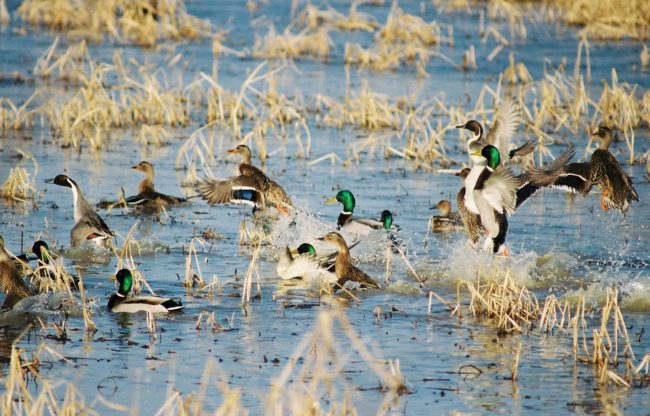
By Joan Howe, Refuge Ranger
Springville, Tenn.–With a stroke of a pen on December 28th, 1945, then President Harry S. Truman created the Tennessee National Wildlife Refuge along 65 miles of the Tennessee River and the newly formed Kentucky Lake. Although it was an overlay refuge on TVA lands, this new refuge would be managed by the US Fish and Wildlife Service as a critical overwintering habitat for waterfowl and other migratory birds.
This year the refuge turns 75 years old, however it plans on making 2021 the year to celebrate. The state of the current pandemic will dictate final plans on exactly what that celebration will look like. However, October 23rd is the date it hopes to really pull out all the stops for a large event at the refuge visitor center. Throughout the year, the refuge hopes to put on smaller events such as a Bioblitz hosted by TVA on May 22nd.
Ranger Joan Howe said, “We are also trying to get creative on how we can celebrate with the public and keep them safe and healthy at the same time. Details of those plans will be forthcoming in the new year!”
The refuge was created with most of its 51,385 acres entire at one time, with very small tracts added in later years. This refuge was designed to be a heavily managed refuge to provide food, shelter and sanctuary for the many ducks and geese that pass through this area during the winter. The refuge consists of three separate units that incorporated the confluence of rivers joining the Tennessee River. The Big Sandy Unit includes the area where the Big Sandy River joins the Tennessee River. The Duck River Unit includes the mouth of the Duck River and the Busseltown Unit has Cub Creek within its borders. Each of these areas has historically been a major attraction for many migratory birds.
In peak times during very cold winters such as in 2018, the refuge has seen waterfowl numbers reach 250,000 – 300,000 ducks of 24 different species and 10,000 geese of 5 different species. Its signature species is the American Black Duck as the refuge is an extremely important overwintering area for this species, which is experiencing declines in population numbers. Historically, the refuge wintered 20-30% of the black ducks in the Mississippi flyway, however current numbers may not be that high.
Besides waterfowl, the American Bird Conservancy classifies the refuge as a globally important bird area for the wide diversity of habitats used by many different migratory and non-migratory birds. In a state that has a total of approximately 411 bird species, this refuge has found 316 species using the refuge. This includes hawks, eagles, osprey and other raptors, shorebirds, rails, gulls, terns, cranes and many different species of songbirds. Fortunately, the land management for these migratory birds creates habitat that attracts many different species of mammals, amphibians, reptiles, butterflies, and other insects.
On the refuge, half the acreage is either shallow wetlands or open water. Due to the high aquatic species diversity in the Duck River and the Tennessee River, where the two join together has a higher diversity than any other inland refuge in the country. The refuge has documented 144 species of fish, which is more fish species than all the great lakes combined! Also, the refuge is known for its incredible number of mussels that are found in the same area.
Several dynamic individuals have served to develop and oversee the management of the refuge. The first refuge manager was Chester Markley who served from its creation in 1945 to 1954. Vandiver L. Childs, better known to the community as V.L. Childs was the longest-term manager serving 28 years until retiring in 1982. Carrell Ryan served to 1991, until handing the reigns to John Taylor who served until his retirement in 2010. Today the refuge is in good hands under Barron Crawford, who earlier in his career was a deputy manager under John Taylor.
In 2014, the refuge opened a state-of-the-art visitor center that included an exhibit hall, nature bookstore, auditorium, and classroom all overlooking a scenic view along a bay of Kentucky Lake. Adjacent to the visitor center is a demonstration pollinator garden, and two hiking trails. Although this visitor center is temporarily closed due to Covid-19 concerns, this visitor center is normally open Monday-Saturday from 8:00 – 4:30 pm and is free to the public.
Crawford commented “Many folks have asked when we thought the visitor center will be re-opened. The answer is we don’t really know, as it all depends on what is happening with the coronavirus spread in our community.”
Created in 2004, the Friends of Tennessee National Wildlife Refuge has been an invaluable partner with the refuge. The Friends main mission is helping to grow the refuge’s volunteer program, advocate for the refuge in the local communities and to grow more opportunities offered to visitors in terms of events and environmental education. Pre-pandemic, the refuge provided free all-day field trips to 3,600 students annually from nine different counties. The refuge Friends group provided bus transportation dollars to assist schools in bringing students to the refuge. Linda Fields, President of the Friends of TNWR said “We really miss those kids coming to the refuge lately. Well really, we miss everyone, but there is nothing like having the place full of kids that are super excited to be there! We are all hopeful that in 2021 we can get back to the business of hosting events and field trips to the refuge again.”
While the visitor center remains closed, at least for now, the refuge land is open to visit. “The waterfowl and many more bird are here” said Ranger Joan Howe. “We invite you to come on down to the refuge and take a drive around to see the many birds that call this place home for the winter. Our sanctuary bays are packed for the moment giving great opportunities to see large numbers fairly easily.”
While the pandemic has paused some of the refuge’s visitor programs temporarily, one thing is clear, the birds and other wildlife continue to flourish here. In 2021, we hope to celebrate that in style!



